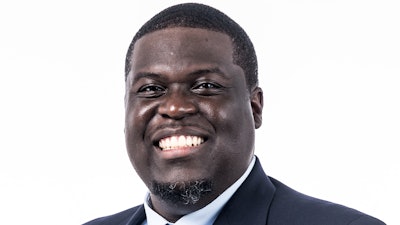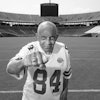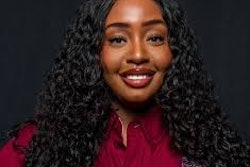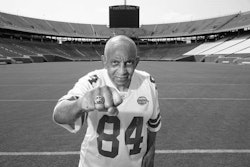Each fall, Charmin Smith, head women’s basketball coach at University of California, Berkeley, welcomes three other Black female Division I head coaches and their teams to campus for the Raising the B.A.R. (Basketball Activism and Representation) Invitational. She rebranded Cal’s annual tournament to reflect a focus on social justice and equity.
 Dr. Aaron Goodson
Dr. Aaron Goodson
Smith acknowledges that much progress has been made since she was a student-athlete at Stanford University in the 1990s — notably DEI divisions in athletic departments — but most athletic staffs don’t reflect the student-athlete populations. “We still have an industry in which the people making the hires are predominantly white males,” she says.
Action taken
While there has been steady advancement over the past 40 years, the murder of George Floyd in 2020 has proven to be a seminal moment that has propelled student-athletes, coaches, and administrators to face issues of race and racism in college sports. As the Black Lives Matter movement mobilized after Floyd’s death, Black student-athlete groups were formed around the country that openly stated their issues and insisted that administration recognize their concerns.
Dr. Aaron Goodson, director of mental health and performance for Duke University Athletics, notes that Black student-athletes have long built community, but “in 2020, there was a demand in a lot of ways for it to be formally recognized.
“Saying, ‘I want [administration] to not only formally acknowledge but provide support for me and my peers to feel safe, comfortable, and valued,’” he says. “They were making demands and holding administration’s feet to the fire.”
Goodson says a key issue he and his department address is that student-athletes are typically ages 17 to 23, a crucial time of identity development. Among the things young people explore is how the world perceives them, which can be discouraging for people of color who feel like they are only valued for their athletic accomplishments.
“The sense of belonging, the sense of understanding self, and the questions about the implications of what that means for their life experience all come into play,” says Goodson, who works with students individually and in team settings.
Part of the demands that intensified in 2020 was the call to make athletic departments more diverse. Goodson says one of the actions that Duke took was to make more support available from mental health professionals of color. He says he also looks forward to collaborating with faculty on campus to pursue and publish research on issues related to student-athletes of color.
 University of California, Berkeley, Head Women’s Basketball Coach Charmin Smith, second from left, hosts the annual Raising the B.A.R. Invitational to promote social justice and equity.
University of California, Berkeley, Head Women’s Basketball Coach Charmin Smith, second from left, hosts the annual Raising the B.A.R. Invitational to promote social justice and equity.
History of change
Carter-Francique mentions the formation in the mid-2000s of the diversity and inclusion office at the NCAA, established by the late Dr. Myles Brand during his presidency. Although the work already existed, formally centering it as an asset of college athletics was significant.
“To take a stand on elevating that conversation and recognizing not only students, but also staff, coaches, and administrators in that space . . . was key,” says Carter-Francique. “Also, that office started some of the programming to promote the preparation of Black and Brown individuals and women to prepare for leadership roles in college sports.”
In 2016, the NCAA created the Presidential Pledge, stating a commitment to promoting and achieving ethnic, racial, and gender equity in intercollegiate athletics. Four years later, 82.8% of Division I institutions had signed the pledge, but only 68.6% of athletic conferences.
Attorney Sarah Mullen of Lewis Rice LLC, a St. Louis-based law firm with a national sports practice, notes an important 2021 legal decision that impacted DEI. The U.S. Supreme Court’s NCAA v. Alston decision limits the NCAA’s ability to regulate and govern education-related benefits for student-athletes that increase access to internships and graduate school.
The firm is consulted by colleges and universities on DEI and Title IX issues, but often such requests come after a complaint has been filed.
“We have been able to make structural recommendations about [staff] training that can happen, about complaint procedures and about opportunities to communicate better that the university or athletic department can implement,” Mullen says. “I think the dynamic is changing. Not just because student-athletes have found their voices on social issues they care about, but also because the economic power is starting to shift more in favor of the college athlete.”
 The McLendon Foundation’s leadership initiative has counted 171 minorities hired in collegiate or professional sports in careers including creative content, marketing, and facilities.
The McLendon Foundation’s leadership initiative has counted 171 minorities hired in collegiate or professional sports in careers including creative content, marketing, and facilities.
For several years, the NCAA tried to craft name, image, and likeness (NIL) regulations. On June 30, 2021, and with mounting pressure due to states passing laws allowing student- athletes to profit from their NIL, the NCAA issued an interim rule. On July 1, 2021, the deals commenced.
NIL
While the NCAA remains opposed to pay-for-play, NIL is a reality in college sports. The large deals with big corporations receive the attention, but student-athletes at every level are trying to capitalize.
Mick Hamilton, vice president of operations at Icon Source, a digital sports marketing company, participated in two of the first NIL deals, one of which involved football player Antwan Owens of Jackson State University, an HBCU institution. Hamilton does not see a racial divide in who is receiving substantial NIL dollars, but he does see a huge gender divide. Aside from a few sponsorships involving Division I female basketball players, most big-dollar deals go to football and men’s basketball players.
A significant area where female student-athletes are largely left out in the cold is the collectives. These are generally institution specific. While there is some variance in their models, collectives are organizations in which alumni come together to form a company with the goal of providing NIL opportunities to student-athletes of that institution. More than 100 schools have collectives, including Power Five institutions.
“That’s where female athletes and non-revenue-generating sports are lacking,” says Hamilton. “They’re not seeing those dollars.”
Any student-athlete can set up an Icon Source profile, which companies can see and make offers. An example is Sprouts Farmers Market, a grocery store chain that wanted to do a campaign related to Title IX with nine women. Another company is Academy Sports + Outdoors, which has both male and female student-athletes make in-store appearances. When it comes to smaller campaigns such as these, female student-athletes have the edge.
“The athletes that are thriving in this space . . . are the ones who understand social media, how to create a brand, [and] understand Tik Tok and content creation,” Hamilton says.
Education
 Sarah Mullen
Sarah Mullen
Data from TIDES reports have fueled efforts to create meaningful change in college sports, and there has been improvement. Carter-Francique says the TIDES reports have also impacted hiring practices as Lapchick has tracked the race and gender compositions of athletic departments at Division I, Division II, and Division III NCAA member institutions.
“We see a little bit more hiring of Black coaches, but . . . if they do not turn in a winning season in some duration of their contracts, then they don’t get a second chance,” says Carter-Francique. “The culture within college sport maintains some of the racialized stereotype notions of the intelligence level of Black coaches or their ability to handle the pressure. . . It’s difficult to see a great shift in those numbers.”
The Knight Commission on Intercollegiate Athletics is a panel of academic and athletic leaders. It advocates for various reforms to intercollegiate athletics with an emphasis on academic values and policies that student-athletes receive meaningful and useful educations.
“One of our major points in our report of 2021 called for measures that would hold institutions accountable in recruitment and hiring to achieve diversity and equity in athletics leadership,” says Amy Perko, CEO of the Knight Commission. “One of our other recommendations was to close the educational opportunity gaps for Black college athletes’ success. We have specifically called on the NCAA to adopt a racial equity filter in the awarding of its academic incentives.”
 Mick Hamilton
Mick Hamilton
“Unfortunately, it took the NCAA 10 years to adopt our recommendation that teams had to be on track to graduate at least 50% of their players to be eligible for post-season,” Perko says. “By being persistent, that standard was ultimately adopted, and it has helped lead to record graduation rates for Division I athletes.”
Among student-athletes who graduate in addition to non-athletes are individuals who aspire to careers in sports on the administrative side. Adrien Harraway, senior vice president of the National Association of Collegiate Directors of Athletics (NACDA) and director of the McLendon Foundation, is responsible for the foundation’s leadership initiative. The fourth cohort of fellows is underway. Thus far, 171 individuals who identify as minorities have been hired in either collegiate or professional sports in a range of careers, including creative content, marketing, and facilities.
“Within their terms, they not only work at a host institution (for approximately 10 months), but they get professional development from us,” says Harraway.
Harraway praises the institutions, teams, and corporations that have embraced this leadership program, including contributing money to the McLendon Foundation to subsidize the fellows’ stipends.
“They have leaned into our program and have provided opportunities to these young people who are trying to get their foot in the door,” says Harraway, a former student-athlete whose career began with a NACDA internship. “We’re trying to create access and opportunity.”
As these fellows become employed and rise in the ranks, the pipeline to senior positions will swell.
“I tell the new cohort, ‘exposure equals expansion,’” says Harraway. “As long as we keep bringing young people into athletics, it’s going to get better. I’m hopeful we won’t be talking about this in 20 years.”


















